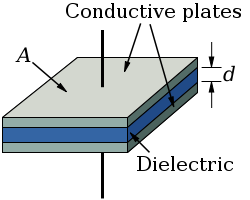Using Capacitors to Measure Fluid Level: Difference between revisions
| Line 11: | Line 11: | ||
The magnitude of the electric field within a capacitor is <math>\left| \vec{E}_{capacitor} \right| = \frac{Q/A}{\epsilon_{0}}</math>, where the gap is only occupied by free space. <math>Q</math> is the charge on a plate and <math>A</math> is the area of a plate. Additionally, <math>\epsilon_{0}</math> is the permittivity of free space as detailed [[Constants|here]]. | The magnitude of the electric field within a capacitor is <math>\left| \vec{E}_{capacitor} \right| = \frac{Q/A}{\epsilon_{0}}</math>, where the gap is only occupied by free space. <math>Q</math> is the charge on a plate and <math>A</math> is the area of a plate. Additionally, <math>\epsilon_{0}</math> is the permittivity of free space as detailed [[Constants|here]]. | ||
With a dielectric involved, we apply the equation <math>\vec{E}_{dielectric} = \frac{\vec{E}_{applied}}{K}</math>, where <math>K</math> is the dielectric constant of the material, and get <math>\left| \vec{E}_{dielectric} \right| = \frac{Q/A}{K\epsilon_{0}}</math>. The capacitance, <math>C=\frac{Q}{V}</math> (where <math>V</math> is the voltage) or <math>C=\frac{\epsilon_0 A K}{d}</math>, therefore changes with a varying dielectric constant | With a dielectric involved, we apply the equation <math>\vec{E}_{dielectric} = \frac{\vec{E}_{applied}}{K}</math>, where <math>K</math> is the dielectric constant of the material, and get <math>\left| \vec{E}_{dielectric} \right| = \frac{Q/A}{K\epsilon_{0}}</math>. The capacitance, <math>C=\frac{Q}{V}</math> (where <math>V</math> is the voltage) or <math>C=\frac{\epsilon_0 A K}{d}</math>, therefore changes with a varying dielectric constant. | ||
=== | ===Relating Capacitance to Fluid Level=== | ||
When multiple materials are between the gap, for instance water and air, the overall capacitance would be <math>C=\epsilon_0 A (\frac{K_{water}}{d_{water}}+\frac{K_{air}}{d_{air}})</math>, where <math>d=d_{water}+d_{air}</math> and <math>K_{air} \approx 1</math>. | |||
===A Computational Model=== | ===A Computational Model=== | ||
Revision as of 21:47, 5 December 2015
Measuring the level of a fluid is useful for a variety of applications, and the technology for the techniques employed in the acquisition of this measurement has progressed far beyond the use of sight glasses and mechanical floats. In fact, a widely used method to measure the amount of fuel in a gas tank is with a device that floats on top of the fuel combined with a sensor, the fuel gauge sending unit, that translates the angle of the float to the amount of fluid in the tank. With this method, the gauge tends to change position with the angle of the car as well as the angle of the float relative to the fluid, so a lot of the time the gauge position can be misleading. A more modern technique of measuring fluid level involves capacitors, and this article will detail the concepts and mathematics behind the relationship with fluid height.
Conceptual Background
Capacitors
For more details, see capacitor.

A capacitor consists of two conductors, e.g. conducting plates, separated by some kind of insulator. The insulator--a dielectric--within the gap between the two conductors can be air, plastic, glass, etc. Additionally, the conductors have to be connected to some sort of power supply in order to acquire a buildup of charge on the surface of the conductors.
The magnitude of the electric field within a capacitor is [math]\displaystyle{ \left| \vec{E}_{capacitor} \right| = \frac{Q/A}{\epsilon_{0}} }[/math], where the gap is only occupied by free space. [math]\displaystyle{ Q }[/math] is the charge on a plate and [math]\displaystyle{ A }[/math] is the area of a plate. Additionally, [math]\displaystyle{ \epsilon_{0} }[/math] is the permittivity of free space as detailed here.
With a dielectric involved, we apply the equation [math]\displaystyle{ \vec{E}_{dielectric} = \frac{\vec{E}_{applied}}{K} }[/math], where [math]\displaystyle{ K }[/math] is the dielectric constant of the material, and get [math]\displaystyle{ \left| \vec{E}_{dielectric} \right| = \frac{Q/A}{K\epsilon_{0}} }[/math]. The capacitance, [math]\displaystyle{ C=\frac{Q}{V} }[/math] (where [math]\displaystyle{ V }[/math] is the voltage) or [math]\displaystyle{ C=\frac{\epsilon_0 A K}{d} }[/math], therefore changes with a varying dielectric constant.
Relating Capacitance to Fluid Level
When multiple materials are between the gap, for instance water and air, the overall capacitance would be [math]\displaystyle{ C=\epsilon_0 A (\frac{K_{water}}{d_{water}}+\frac{K_{air}}{d_{air}}) }[/math], where [math]\displaystyle{ d=d_{water}+d_{air} }[/math] and [math]\displaystyle{ K_{air} \approx 1 }[/math].
A Computational Model
How do we visualize or predict using this topic. Consider embedding some vpython code here Teach hands-on with GlowScript
Examples
Be sure to show all steps in your solution and include diagrams whenever possible
Simple
Middling
Difficult
Connectedness
- How is this topic connected to something that you are interested in?
- How is it connected to your major?
- Is there an interesting industrial application?
History
Put this idea in historical context. Give the reader the Who, What, When, Where, and Why.
See also
Are there related topics or categories in this wiki resource for the curious reader to explore? How does this topic fit into that context?
Further reading
Books, Articles or other print media on this topic
External links
References
This section contains the the references you used while writing this page